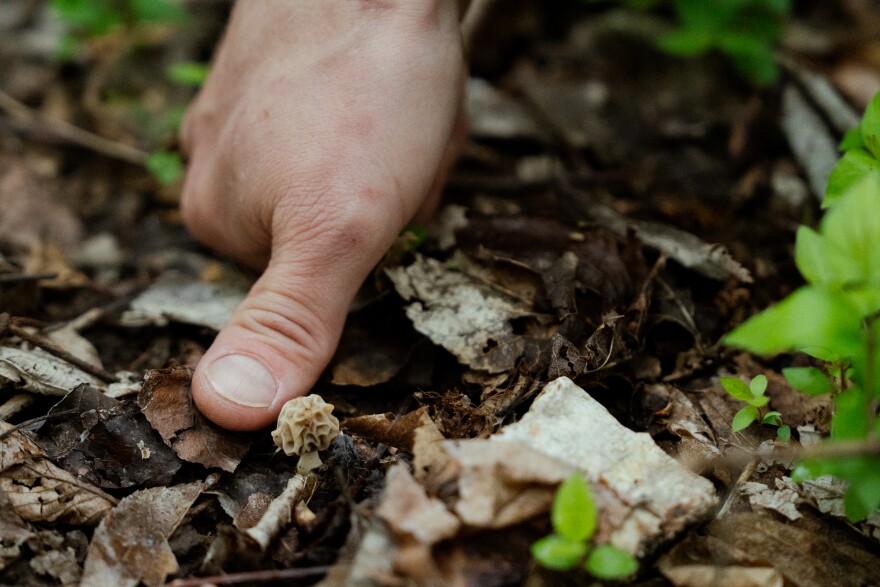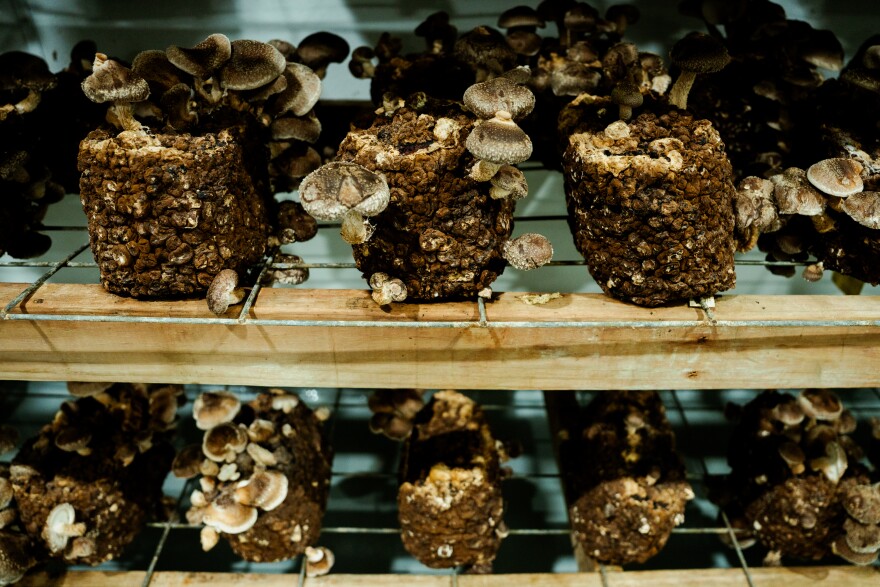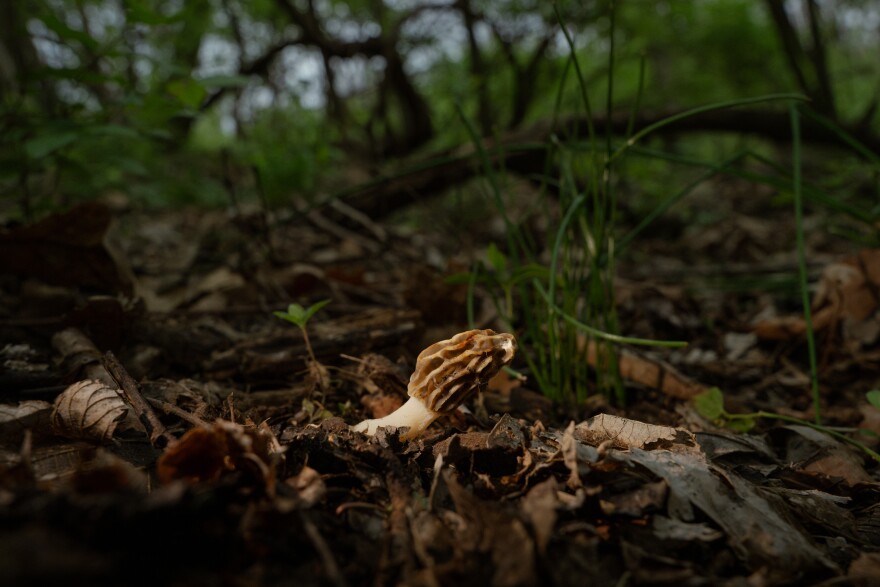In a wooded area behind his Missouri mushroom farm, J.T. Gelineau sets out on a misty morning. He crosses a small creek and ducks under thick tangles of honeysuckle, scanning the ground.
There are a lot of lookalikes out here — walnut shells, pitted limestone rocks, leaves that have decayed to just a stencil.
“All of these things initially have that kind of honeycomb appearance that, if they're the right color, will really catch your eye,” Gelineau said.
Eventually he finds what he’s looking for; a tiny morel mushroom, the size of Gelineau’s thumbnail.
“This is the smallest one I’ve found yet,” he said, laughing with surprise.

Less than a mile away, in a brightly lit, humid room, Gelineau mimics spring conditions year-round. While he is able to cultivate a myriad of fungi indoors at his farm, Gelineau still has to hunt for morels in the woods.
Despite a growing market for other varieties of specialty mushrooms, the morel is a springtime delicacy that largely evades captivity. But some Midwesterners are starting to unlock the morel’s secrets and think a method for widespread morel farming could be in the near future.
Specialty farms
Gelineau’s O’Fallon, Missouri, mushroom business started in his basement, using techniques he learned from mushroom-growing internet forums.
“I was the only weirdo on there trying to grow edible mushrooms instead of psychedelics,” he said.
Ten years later, his business Mushrooms Naturally now sells at farmer’s markets, offers home cultivation classes and sells mushroom growing kits. In March the business moved into a new facility that has a professional kitchen for cooking classes and labs for cultivation.
In the brightly lit, humid grow room at Mushrooms Naturally, bags of wood chips and logs are host to shiitake, hen of the woods, king oyster and lion’s mane mushrooms.

These varieties, known as specialty mushrooms, are part of a growing trend of small and urban farms that offer something different from the white button or portobello mushrooms mass-produced and sold at grocery stores.
They’re a relatively recent development in the U.S., according to Connor Youngerman, an extension support specialist at the Cornell Small Farms Program. Since the 1980s, the market has taken off, he said, partly driven by demand from Asian American communities whose food cultures prize shiitakes and oyster mushrooms.
“Overall, mushroom production is increasing,” Youngerman said. “Mushroom farmers, there are more and more of them every year.”
But there are still varieties of mushrooms, including morels, that typically aren’t grown at specialty farms because their life cycles are tricky to replicate.
“Morels are a mysterious and romantic and strange mushroom,” he said. “They fit somewhere in between wild mushrooms that you can forage and specialty mushrooms.”
Bags of hope
Figuring out how to grow morels has become a tantalizing quest for some.
“It's pretty uncommon to find folks cultivating morels,” said Gregory Bonito, a professor at Michigan State University. “The technology’s still being worked out."
A 2017 trip to China sparked Bonito’s interest in trying to grow morels in the Midwest.
“I saw black morels being cultivated there, and that really caught my attention, because I had heard news of it for maybe five years prior, but I'd never seen it with my own eyes, and, as they say, seeing is believing,” he said.
Bonito led a recent research project that had farmers growing morels at more than a dozen sites in Ohio, Michigan, Wisconsin and Illinois. The experiment was part of the U.S. Department of Agriculture’s Sustainable Agriculture Research and Education program.
“All the farmers were successful growing them, although in our climate, with these approaches, it wasn't economically sustainable,” he said.
The deep winters of the region and issues with rodents led to lower production levels than would be needed to turn a profit.
“I think we're close, we're there,” Bonito said. “Scaling up is going to take more investment from private companies, or better yet, the state or federal government.”
But the methods that Bonito studied don’t work for the common yellow morel, or Morchella Americana, that is fruiting right now across the Midwest, he said.
“To be frank, no one really understands the ecology of these yellow morels or why they are not able to be cultivated yet,” he said.

Wisconsin-based Field and Forest Products sells a variety of mushroom spawns and cultivation supplies to commercial farmers and hobbyists across the country, including morel spawn.
The company started selling the spawn about five years ago, said Chief Mycologist and Research Director Lindsey Bender. Field and Forest guarantees its culture is capable of producing a fruiting morel body, and Bonito has tested the spawn to confirm that, but the company is clear that it’s still experimental, with a disclaimer that calls the product “a fine bag of hope.”
“Despite this being really our only mushroom strain that we don't guarantee success, people don't bat an eye,” Bender said. “They are just excited to be a part of this development.”
Bender thinks in the next few years, American growers could catch up to the Chinese and be able to widely cultivate morels.
“We are close here in the Midwest,” Bender said. “Whether that's a dependable crop, something that is sustainable for growers to get into, remains another question.”
And besides the sustainability, Bender said she knows plenty of morel foragers that don’t want scientists to solve this challenge.
Foraging
After almost 60 years hunting for morels in Nebraska, Tersh Kepler is one forager who hopes commercial farming never unlocks the secrets of his favorite mushroom.
“I honestly don't think they're ever going to figure that one out, at least, hopefully not in my lifetime,” Kepler said. “It's an adult Easter egg hunt, is what it's like. I don't want that to ever change.”
Kepler sells hiking sticks with carved morel handles and mesh collection bags online. He also teaches introductory foraging classes through Nebraska Games and Parks and has a few tips for people who are hoping to learn to hunt morels.
“If they have no experience, the first thing is, take your time,” Kepler said. “People seem to walk too fast and rush too quickly.”
He advises people to start their hunt at creeks or rivers and work their way to higher ground, looking out for recently dead trees that he said often have morels nearby.

Kepler said it’s important to know where you are hunting and be careful not to trespass. Foragers should also wear tick protection, because the disease-carrying parasites are often abundant in places morels thrive.
Michigan State’s Bonito said food safety is key if people are going to forage. Fungi can sequester metals and toxins from the environment, so mushroom hunters don’t want to collect in places with a history of pesticide applications or other environmental concerns.
Bonito said it’s also extremely important to cook the mushrooms.
“Morel mushrooms, all mushrooms, really, need to be cooked before they're consumed,” Bonito said. “In fact, there's been a few deaths linked to the consumption of raw morels.”
Once he’s got a haul in Missouri, Gelineau likes to keep it simple, cooking morels up with a little bit of oil and a touch of pink salt, to caramelize the mushrooms and bring out their unique flavor.
“My chef-ness, towards the end of winter, kind of hibernates,” Gelineau said, “But as soon as morels start popping up and other little things start shooting up in the garden, my creativity just kind of spurs back up.”
Youngerman, who also forages for morels in his free time, said the mushroom can inspire more than creativity.
“They're a good gateway mushroom into the world of foraging,” he said. “Once you get comfortable with hunting morels in the spring, then it's like, ‘Oh, well, what's out next?’”
This story was produced in partnership with Harvest Public Media, a collaboration of public media newsrooms in the Midwest and Great Plains. It reports on food systems, agriculture and rural issues.


